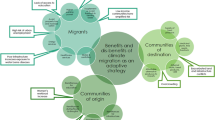Abstract
Bangladesh is one of the most vulnerable countries in the world to the impact of climate change, evidence of which seems to be present all over the country. The cities and towns also face severe impacts. Dhaka, the capital of Bangladesh and one of the largest metropolitan regions in the world, is facing many adverse impacts of climate change, both directly and indirectly. Dhaka accommodates many internally displaced populations, along with other impacts from climatic hazards. From this perspective, the present research aims to explore the context of migration to Dhaka due to climate change and environmentally induced problems, as well as the adaptation strategies of the migrants as they arrive at the city. This study is based on primary data collected from a large census of 12,078 migrant households in the Dhaka Metropolitan Region. Around 20.9 percent of these households were identified as having left their place of origin due to climate change-induced factors. A random sample of 553 households was selected from this sub-group of “climate change-induced migrants” (climate migrants) for a sample survey in the final phase of the analysis. Our study revealed that immediately after migration, the majority of the mostly unskilled jobs found by this group was in the informal sector although, over time, the migrants tried to upgrade to more skilled sectors. More than two-thirds of the surveyed households enhanced their income after a prolonged stay in the city although some failed to reach their pre-migration level of income. The study findings reveal that despite a lack of institutional support, Dhaka City remains the major destination point for climate migrants and that the city ultimately accommodates them, enabling them to earn livelihoods in their adopted metropolitan environment. Our research hopes to draw attention to the multifaceted issues connected to climate change-induced migration to the big cities, where a well-coordinated approach is needed to address them.
Access this chapter
Tax calculation will be finalised at checkout
Purchases are for personal use only
Similar content being viewed by others
References
Afsar R (2000) Rural-urban migration in Bangladesh: Causes, consequences, and challenges. University Press Limited
Afsar R (2003) Internal migration and the development nexus: The case of Bangladesh. In: Regional conference on migration, development and pro-poor policy choices in Asia, p 22–24
Albo A, Alscher S (2011) Foresight: migration and global environmental change, final project report. The Government Office for Science, London
Black R, Bennett SRG, Thomas SM, Beddington JR (2011) Climate change: migration as adaptation. Nature 478(7370):447
Édes BW, Gemenne F, Hill J, Reckien D (2012) Addressing climate change and migration in Asia and the Pacific: open access e-book. Asian Development Bank
Harris JR, Todaro MP (1970) Migration, unemployment and development: a two-sector analysis. Am Econ Rev 60(1):126–142
International Organization for Migration (IOM) (2007) Discussion note: migration and the environment, Ninety-Fourth Session. International Organization for Migration, Geneva
Ishtiaque A, Nazem NI (2017) Household-level disaster-induced losses and rural-urban migration: experience from one of the world’s most disaster-affected countries. Nat Hazards 86(1):315–326. https://doi.org/10.1007/s11069-016-2690-5
Jäger J, Frühmann J, Grünberger S, Vag A (2009) EACH-FOR: Environmental change and forced migration scenarios, synthesis report. Available via: https://www.each-for.eu
Jones G, Mahbub AQM, Izazul Haq M (2016) Urbanization and migration in Bangladesh. United Nations Population Fund, Bangladesh Country Office
Kniveton D, Schmidt-Verkerk K, Smith C, Black R (2008) Climate Change and migration: improving methodologies to estimate flows. Sussex University, Sussex
Sharma V, Saraswati LR, Das S, Sarna A (2015) Migration in South Asia: a review. Population Council, New Dehli
Siddiqui MR, Hossain MA (2019) Climate change and migration in coastal areas in South Asia.
Siddiqui T (2003) Migration as a livelihood strategy of the poor: the Bangladesh case. Dhaka University, Bangladesh, Refugee and Migratory Movements Research Unit
Thieme S (2006) Social networks and migration: far West Nepalese labour migrants in Delhi (Vol. 7). LIT Verlag Münster.
Todaro MP (1969) A model of labor migration and urban unemployment in less developed countries. Am Econ Rev 59(1):138–148
Vertovec S (2002) Transnational networks and skilled labour migration.
Zhang J (2002) Urbanization, population transition, and growth. Oxf Econ Pap 54(1):91–117
Acknowledgements
The authors wish to acknowledge the financial support of the Bangladesh Climate Change Trust, Ministry of Environment, Forest and Climate Change, Bangladesh in conducting the research.
Author information
Authors and Affiliations
Corresponding author
Editor information
Editors and Affiliations
Rights and permissions
Copyright information
© 2023 The Author(s), under exclusive license to Springer Nature Singapore Pte Ltd.
About this chapter
Cite this chapter
Nazem, N.I., Mahbub, A.Q.M., Hossain, M. (2023). Climate Migrants in the Dhaka Metropolitan Region: The Process of Livelihood Adaptation. In: Mookherjee, D., Pomeroy, G.M., Huong, L.T.T. (eds) Urban Transformational Landscapes in the City-Hinterlands of Asia. Advances in 21st Century Human Settlements. Springer, Singapore. https://doi.org/10.1007/978-981-19-8726-7_21
Download citation
DOI: https://doi.org/10.1007/978-981-19-8726-7_21
Published:
Publisher Name: Springer, Singapore
Print ISBN: 978-981-19-8725-0
Online ISBN: 978-981-19-8726-7
eBook Packages: Earth and Environmental ScienceEarth and Environmental Science (R0)




